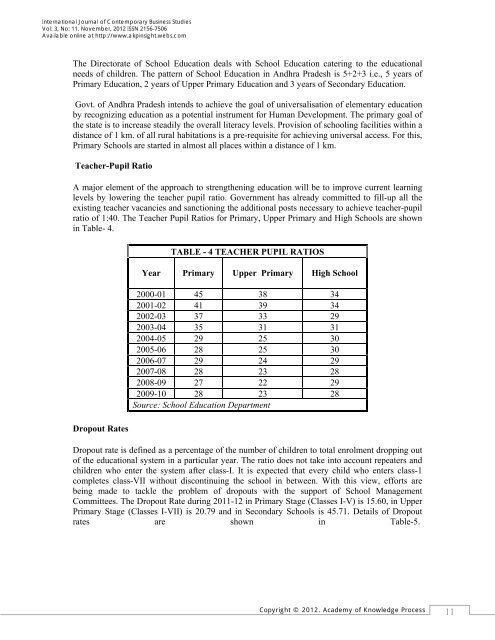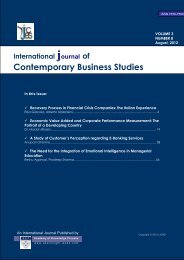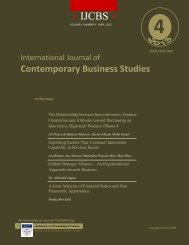International Journal of Contemporary Business Studies
International Journal of Contemporary Business Studies
International Journal of Contemporary Business Studies
You also want an ePaper? Increase the reach of your titles
YUMPU automatically turns print PDFs into web optimized ePapers that Google loves.
<strong>International</strong> <strong>Journal</strong> <strong>of</strong> <strong>Contemporary</strong> <strong>Business</strong> <strong>Studies</strong><br />
Vol: 3, No: 11. November, 2012 ISSN 2156-7506<br />
Available online at http://www.akpinsight.webs.com<br />
The Directorate <strong>of</strong> School Education deals with School Education catering to the educational<br />
needs <strong>of</strong> children. The pattern <strong>of</strong> School Education in Andhra Pradesh is 5+2+3 i.e., 5 years <strong>of</strong><br />
Primary Education, 2 years <strong>of</strong> Upper Primary Education and 3 years <strong>of</strong> Secondary Education.<br />
Govt. <strong>of</strong> Andhra Pradesh intends to achieve the goal <strong>of</strong> universalisation <strong>of</strong> elementary education<br />
by recognizing education as a potential instrument for Human Development. The primary goal <strong>of</strong><br />
the state is to increase steadily the overall literacy levels. Provision <strong>of</strong> schooling facilities within a<br />
distance <strong>of</strong> 1 km. <strong>of</strong> all rural habitations is a pre-requisite for achieving universal access. For this,<br />
Primary Schools are started in almost all places within a distance <strong>of</strong> 1 km.<br />
Teacher-Pupil Ratio<br />
A major element <strong>of</strong> the approach to strengthening education will be to improve current learning<br />
levels by lowering the teacher pupil ratio. Government has already committed to fill-up all the<br />
existing teacher vacancies and sanctioning the additional posts necessary to achieve teacher-pupil<br />
ratio <strong>of</strong> 1:40. The Teacher Pupil Ratios for Primary, Upper Primary and High Schools are shown<br />
in Table- 4.<br />
Dropout Rates<br />
TABLE - 4 TEACHER PUPIL RATIOS<br />
Year Primary Upper Primary High School<br />
2000-01 45 38 34<br />
2001-02 41 39 34<br />
2002-03 37 33 29<br />
2003-04 35 31 31<br />
2004-05 29 25 30<br />
2005-06 28 25 30<br />
2006-07 29 24 29<br />
2007-08 28 23 28<br />
2008-09 27 22 29<br />
2009-10 28 23 28<br />
Source: School Education Department<br />
Dropout rate is defined as a percentage <strong>of</strong> the number <strong>of</strong> children to total enrolment dropping out<br />
<strong>of</strong> the educational system in a particular year. The ratio does not take into account repeaters and<br />
children who enter the system after class-I. It is expected that every child who enters class-1<br />
completes class-VII without discontinuing the school in between. With this view, efforts are<br />
being made to tackle the problem <strong>of</strong> dropouts with the support <strong>of</strong> School Management<br />
Committees. The Dropout Rate during 2011-12 in Primary Stage (Classes I-V) is 15.60, in Upper<br />
Primary Stage (Classes I-VII) is 20.79 and in Secondary Schools is 45.71. Details <strong>of</strong> Dropout<br />
rates are shown in Table-5.<br />
Copyright © 2012. Academy <strong>of</strong> Knowledge Process<br />
11

















